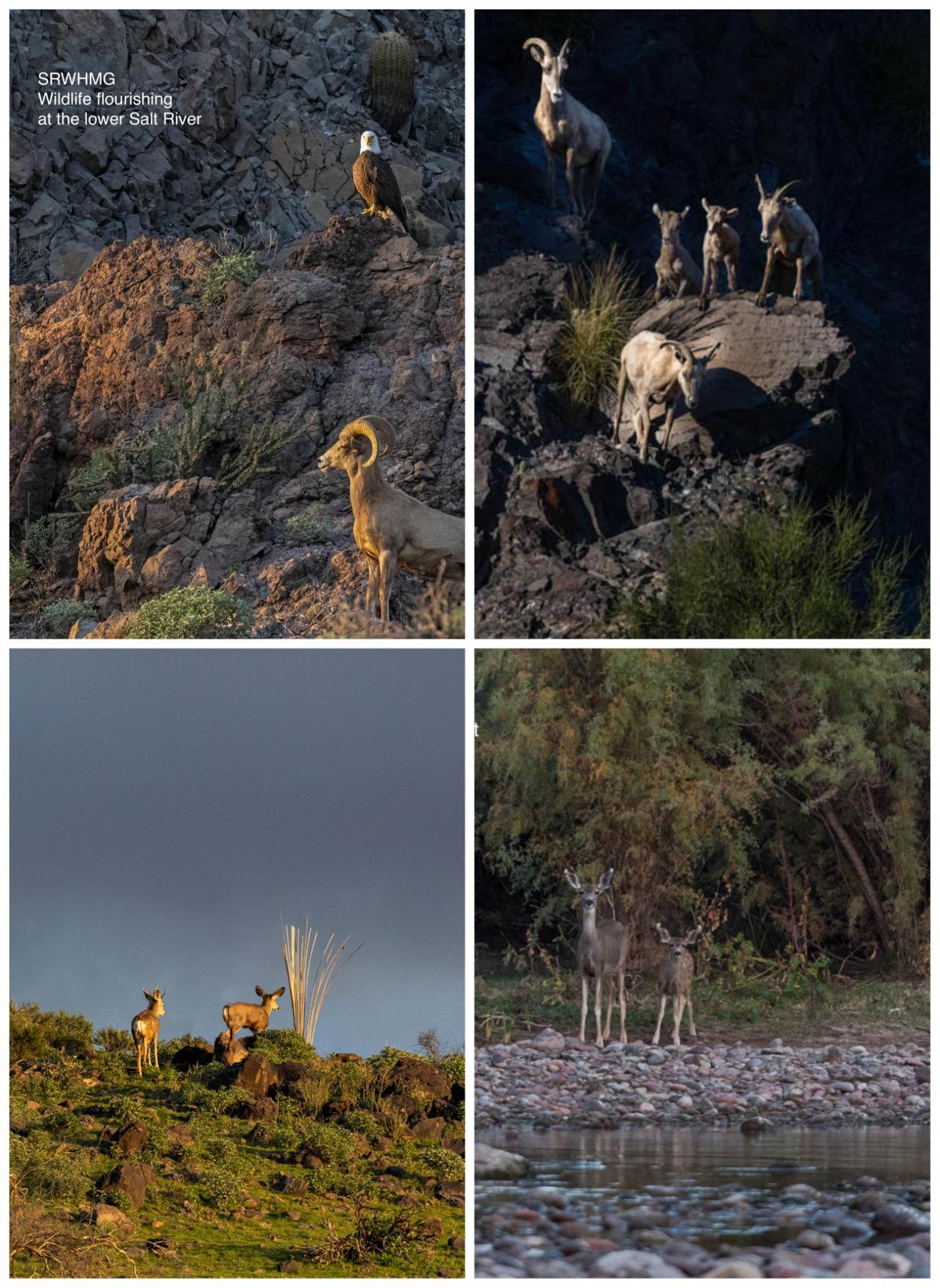Major Legal Win for Salt River Wild Horse Protection
Tonto National Forest Successfully Defends Humane Treatment of Wild Horses While Apache Sitgreaves National Forest Blatantly Disregards It
Phoenix, AZ (December 5, 2023) – The lawsuit aimed at overturning the humane management program that is protecting the Salt River wild horses in the Tonto National Forest has been dismissed by the U.S. District Court for the District of Arizona, Phoenix Division.
The lawsuit was filed in April of this year by the Center for Biological Diversity (CBD) and sport hunting organizations. It contained numerous factual inaccuracies about the Salt River wild horses. It also omitted any reference to the state law protecting the horses and authorizing the Arizona Department of Agriculture to manage them.
The complaint alleged that the United States Forest Service (USFS) failed to follow the National Environmental Policy Act (NEPA) related to the Intergovernmental Agreements (IGA) and the management plan. Yet it neglected to mention that the Salt River wild horse habitat area was analyzed under NEPA in the Final Environmental Impact Statement (FEIS) for the Tonto National Forest Plan issued in March of 2022.
On July 31, the U.S. Forest Service (USFS), which manages the nation’s national forests, including the Tonto National Forest, filed a motion to dismiss the lawsuit. At this point, the Salt River Wild Horse Management Group (SRWHMG) and the American Wild Horse Campaign (AWHC) also filed a motion to intervene in the case. The intervention papers corrected misinformation contained in the CBD complaint, including the outright factual errors. The judge granted the USFS’s motion to dismiss the original lawsuit, but allowed the CBD an additional 30 days to amend its complaint. The 30-day deadline was on Nov. 30 and no amendments were filed.
The case is now effectively dismissed in the lower courts.
“We commend the USFS Tonto National Forest for filing a motion to dismiss the lawsuit and for continuing to work with the state on the humane management of these beloved wild horses,” said Simone Netherlands, president of the Salt River Wild Horse Management Group. “The court’s decision will allow us to continue to manage and care for the Salt River wild horses, who are beloved by the Arizona public and an important part of our state’s history.”
Netherlands’ group has long advocated for protection of the Salt River wild horses and currently manages them through a partnership with the Arizona Department of Agriculture.
“This was a misguided attempt to destroy a successful, humane wild horse management program. We are pleased the court recognized the lawsuit’s lack of merit and granted the motion to dismiss,” said AWHC Executive Director Suzanne Roy. “The CBD and the sporthunters are completely out of step with the wishes of the public, which stands firmly on the side of protecting the Salt River wild horses as iconic Arizona natural treasures. “
Roy cited recent polling that showed 88 percent of Arizonans support protecting the Salt River wild horses.
The Salt River wild horses in the Tonto National Forest are protected under a state law passed in 2016 in response to public opposition to a USFS plan to eliminate the horses from the forest. The law protects the horses from harassment, shooting, killing, slaughter, and capture and authorizes the Arizona Department of Agriculture (AZDA) to enter into an IGA with the USFS for the management of the horses.
The effective dismissal of the lawsuit came on the same day that the neighboring Apache Sitgreaves National Forest shipped 45 Alpine wild horses to Texas kill pen as part of an ongoing effort to eliminate wild horses from the forest. Noting the stark contrast between the two forests’ approach to wild horse management, Netherlands stated,
“The Apache Sitgreaves National Forest should follow the Tonto National Forest’s lead in managing wild horses humanely. Under no circumstance should the Forest Service ever send horses captured from our public lands to kill pens and slaughter auctions.”
Fortunately, rescue organizations worked together to rescue the 45 Alpine wild horses, however hundreds more are at risk as the Apache Sitgreaves Forest continues to round them up.
The SRWHMG and AWHC are urging the public to contact Randy Moore, Chief of the USFS,(202)205-8439, email Randy.Moore@usda.gov
to urge him to support humane wild horse management with fertility control and to protect wild horses on public lands managed by the USFS from slaughter.
Additional background
 With our humane management in the field, we are showing that there is a better way, as opposed to cruel and expensive removals. Our way is a win-win for the public, as well as for the government, and of course for the horses themselves.
With our humane management in the field, we are showing that there is a better way, as opposed to cruel and expensive removals. Our way is a win-win for the public, as well as for the government, and of course for the horses themselves.
It is puzzling why anyone would want to attack these successful programs, and the state legislation that protects these beautiful horses.
The Plaintiffs (CBD and hunter friends) made claims that are false and contained no scientific evidence to back the allegations. Here are some examples:
To start, the CBD alleged there are 600 Salt River horses. However, the Long-Term Management plan, on which they base their lawsuit, clearly discloses there were 450 horses at the time of its writing in July of 2022. However, the current population is now substantially lower at 313 horses, as of September of 2023. In our SRWHMG database we hold a record of every single horse, if it has ever been on the Tonto National Forest. At the present time 100 of these recorded horses, are not on the forest land at all, and instead reside on the adjoining reservations, making the exact total count only 313 horses in the Tonto National Forest, this includes the birth of the 2 foals of 2023.
An official fly-over helicopter count by the AZDA and BLM in 2022, concluded an estimation of 270 horses. Of course our on the ground counts are more accurate, but the helicopter count confirms that the numbers by CBD are completely fabricated. In addition of the 313 horses, only approximately 150 are roaming near and around the lower Salt River riparian area the complaint refers to, and the other 150 roam the northern high mountain habitat. Water is provided in the northern corridor to accomplish migration wider out from the riparian area. Therefore this petty lawsuit is technically aimed at 150 Salt River horses around the riparian area, NOT 600.
 Second, the complaint omits the fact that the number of foals in this herd is only one or two per year. This is an important detail in order not to mislead a judge.
Second, the complaint omits the fact that the number of foals in this herd is only one or two per year. This is an important detail in order not to mislead a judge.
Furthermore, the CBD and hunter organizations falsely allege that the long-term management plan aims to lower the population to 200 horses over 25-35 years. Please see attached long term management plan proving this is not true. The plan sets a population goal of 100-200 horses to be reached within the next 10 years. The lawsuit is therefore based on false allegations.
The relief the lawsuit seeks is the halt of the fertility control program and other programs that keep the horses safe like maintenance of fencing and rescue of injured horses. It may be obvious that halting the management of the horses, would cause a boom in population, which would then cause more environmental concerns, not less. What is the motive behind encouraging a boom in population if the goal is to protect the environment? This is the big question, and the answer is the dubious fact that the CBD is aiming to make the situation so unsustainable, that there will be a need to roundup the horses. Ours is not the only lawsuit they have filed to try to get rid of wild horses.
Even more falsehoods include the claims that these horses eat cottonwood trees, which we know they do not, and no such evidence exists. We however have years and years of cottonwood pictures young and old, they are quite abundant along the river. Fingers cannot be pointed to horses for cottonwood decline if there is any at all. However, the last few years of long-lasting drought and SRP low water management of only 8 CFS in the Salt River, is hard on all trees, especially water-dependent trees like cottonwoods on the edge of the river. In addition, the recent high floods have caused the washing away of riverbanks along with many saplings, but otherwise, cottonwood trees can be seen in abundance along the Salt River.
Furthermore, the suing parties offer no proof of declining numbers of any of the species mentioned in the lawsuit. In fact all species along the river are living symbiotically together including the horses, who are protected by ARS 3-1491 from slaughter and killing and are determined in that bill NOT to be stray livestock.
Species are doing so well that bighorn sheep are being seen again along the lower Salt River with babies, bald eagle nesting is at an all-time high and deer are seen grazing the abundantly green hills this spring. (see pictures of deer grazing in a healthy environment)
In fact, the only population that is declining along the Salt River, is the horse population.
Plaintiffs omit the fact that horses have many positive impacts on their environment as well, such as their manure that contains live seeds of trees, which at the same time provide a great fertilization bed for saplings until they are established. Most of the trees in the forest have sprouted from horse manure, which helps all other species, especially birds. However, of course the lawsuit does not mention any positive impacts the horses have, as it aims to scapegoat them for all environmental damage.

There are more facts completely omitted by the Center for Biological Diversity:
The Tonto National Forest is visited by 8 million people per year, which does cause severe environmental concerns and problems with pollution. Thousands of tubers, kayakers, 4×4’s, horseback riders sadly leave much trash behind and cause disturbances for natural animals.
While the hunters act like they want to protect wildlife, in actuality they just want to kill wildlife. They are out for the bighorn sheep which have been seen often along the river this season. The over-hunting of birds and furred mammals, impact all animals negatively, including protected species. During the hunting season shots ring loudly all day, all around the lower Salt River. Extreme amounts of hunting related trash and bullets litter the floor of the forest. Even illegal hunting activities, like cruel snares have been found around horse legs, causing a necessary intervention and rescue of horse “Neiman” in 2020 with a snare around his hoof.
With the 8 million yearly visitors and the many different recreational interests, it is obvious that the Tonto National Forest is managing one of the most difficult and highest recreational forests in the nation. Because of their concern for the environment and consideration for public opinion, they have made responsible and sustainable decisions, which are to their discretion and are not applicable to NEPA requirements.
Steps have even been taken out of over-abundant concern for the environment, while the reduction of the herd occurs over time. For example, water troughs have been strategically placed away from the riparian area, which encourage the horses to use the entire 20,000 acres, as opposed to concentrating around the riparian area. The Forest Service has also placed boundary fencing between the reservations and fencing along the roads so that horses are safely confined and don’t escape their 20,000-acre habitat.
The long-term management plan is a responsible management plan, in-line with protecting the environment, in-line with State statute, in-line with the Forest Service NEPA requirements, and in-line with the will of the public. The lawsuit, which seeked to terminate the successful management programs and “do nothing instead”, was frivolous.
Simone Netherlands, president of the Salt River Wild Horse Management Group states; “If the environmental concern was genuine, they would not attempt to halt a successful birth control program, as that would produce a larger and uncontrolled population of horses. Once the population is out of control, then the horses will be removed. It will be far better to stay the course of humanely managing the horses, and all organizations plus the Forest Service should continue to work hard together to reduce and mitigate environmental damage and pollution of the lower Salt River”.
PLEASE Join us in this historic movement to ensure that these beautiful wild horses remain wild and free and managed humanely.
Link to the humane Long Term Management Plan:
